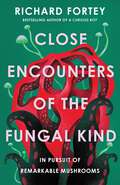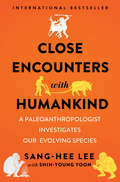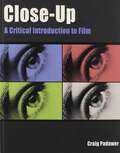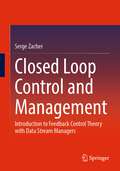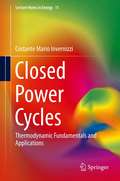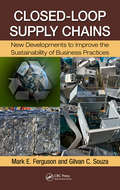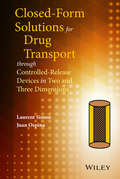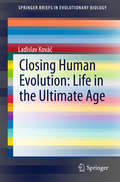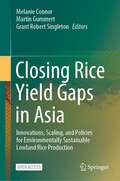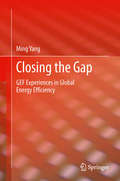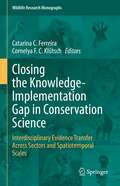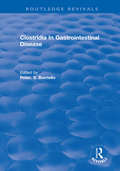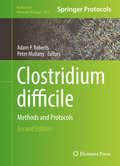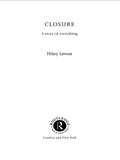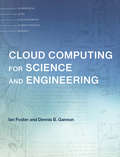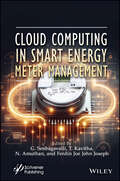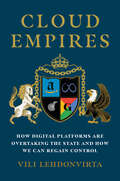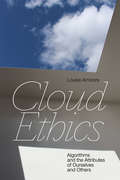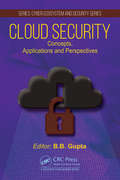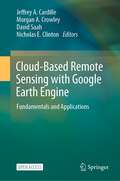- Table View
- List View
Close Encounters of the Fungal Kind: In Pursuit of Remarkable Mushrooms
by Richard ForteyA magical, deeply informed book that takes us from familiar places into the strange world of of fungi.The secret world of fungi is another kingdom. They do things differently there. Diverse beyond our wildest imaginations, fungi don&’t obey rules. They pop up unbidden and often dressed in curious reds and greens. They do not seem of this world, yet fungi underpin all the life around us: the "wood wide web" links the trees by a subterranean telegraph; fungi eat the fallen trunks and leaves to recycle the nutrients that keep the wood alive; they feed a host of beetles and flies, which in turn feed birds and bats. Fungi produce the most expensive foods in the world but also offer the prospect of cheap protein for all; they cure disease, and they both cause disease and kill; they are the specialists to surpass all others; their diversity thrills and bewilders. Professor Richard Fortey has been a devoted field mycologist all his life. He has rejoiced in the exuberant variety and profusion of mushrooms since reading as a boy of nuns driven mad by ergot (a fungus). Drawing on decades of experience, Fortey starts with the perfect "fungus day"—eating ceps in Piedmont. He introduces brown rotters, earthstars, and death caps; fungal annuals and perennials, dung lovers and parasites, even fungi that move through the trees like mycelial monkeys. We learn that the giant puffball produces more spores than there are known stars in the universe and fetid stinkhorns begin looking like arrivals from the planet Tharg. He tells of the fungus that turns flies into zombies, the ones that clean up metallic waste, and the delicious subterranean fungi truffe de Perigord, the delight of gourmets. Amongst these and many other "close encounters," Fortney attempts to answer the questions: what exactly are fungi? Why did their means of reproduction escape discovery for so long? What role do they play in the development of life? The vast kingdom of fungi is more diverse and species rich than plants or animals. By exploring their glorious profusion, Close Encounters of the Fungal Kind reveals so much about their world—and ours.
Close Encounters with Humankind: A Paleoanthropologist Investigates Our Evolving Species
by Sang-Hee Lee Shin-Young YoonIn this captivating bestseller, Korea’s first paleoanthropologist offers fresh insights into humanity’s dawn and evolution. What can fossilized teeth tell us about the life expectancy of our ancient ancestors? How did farming play a problematic role in the history of human evolution? How can simple geometric comparisons of skull and pelvic fossils suggest a possible origin to our social nature? And what do we truly have in common with the Neanderthals? In this captivating international bestseller, Close Encounters with Humankind, Korea’s first paleoanthropologist, Sang-Hee Lee, explores some of our greatest evolutionary questions from new and unexpected angles. Through a series of entertaining, bite-sized chapters, we gain fresh perspectives into our first hominin ancestors and ways to challenge perceptions about the traditional progression of evolution. By combining anthropological insight with exciting, cutting-edge research, Lee’s surprising conclusions shed new light on our beginnings and connect us to a faraway past. For example, our big brains may have served to set our species apart and spur our societal development, but perhaps not in the ways we have often assumed. And it’s possible that the Neanderthals, our infamous ancestors, were not the primitive beings portrayed by twentieth-century science. With Lee as our guide, we discover that from our first steps on two feet to our first forays into toolmaking and early formations of community, we have always been a species of continuous change. Close Encounters with Humankind is the perfect read for anyone curious about where we came from and what it took to get us here. As we mine the evolutionary path to the present, Lee helps us to determine where we are heading and tackles one of our most pressing scientific questions—does humanity continue to evolve?
Close to Home: The Wonders of Nature Just Outside Your Door
by Thor HansonAn award-winning natural-history writer presents "the perfect mix of science and story" (Sy Montgomery), opening the door to the nature that thrives in our yards, gardens, and parks: "I couldn't put it down" (Doug Tallamy). We all live on nature&’s doorstep, but we often overlook it. From backyards to local parks, the natural places we see the most may well be the ones we know the least. In Close to Home, biologist Thor Hanson shows how retraining our eyes reveals hidden wonders just waiting to be discovered. In Kansas City, migrating monarch butterflies flock to the local zoo. In the Pacific Northwest, fierce yellowjackets placidly sip honeydew, unseen in the treetops. In New England, a lawn gone slightly wild hosts a naturalist's life's work. And in the soil beneath our feet, remedies for everything from breast cancer to the stench of skunks lie waiting for someone&’s searching shovel. Close to Home is a hands-on natural history for any local patch of Earth. It shows that we each can contribute to science and improve the health of our planet. And even more, it proves that the wonders of nature don&’t lie in some far-off land: they await us, close to home.
Close to the Machine: Technophilia and Its Discontents
by Ellen UllmanWith a New Introduction by Jaron Lanier A Salon Best Book of the Year In 1997, the computer was still a relatively new tool---a sleek and unforgiving machine that was beyond the grasp of most users. With intimate and unflinching detail, software engineer Ellen Ullman examines the strange ecstasy of being at the forefront of the predominantly male technological revolution, and the difficulty of translating the inherent messiness of human life into artful and efficient code. Close to the Machine is an elegant and revelatory mediation on the dawn of the digital era.
Close-Up: A Critical Introduction to Film
by Craig PadawerClose-Up: A Critical Introduction to Film 1st Edition
Closed Loop Control and Management: Introduction to Feedback Control Theory with Data Stream Managers
by Serge ZacherThe block diagrams as engineering means for closed loop control, which have been established by classic control theory for decades, are replaced in the above mentioned book by networks, the signals are replaced by data. It corresponds to the „Industry 4.0“ and to the structure of today’s automatic control systems. Thereby a classic closed loop is treated not isolated from other elements of nowadays automation like bus communication and process logical control, and is completed in proposed book with new control elements, so called data stream managers (DSM). The proposed book treats the control theory systematically like it is done in classical books considering the new concept of data management. The theory is accompanied in the book with examples, exercises with solutions and MATLAB®-simulations.
Closed Power Cycles: Thermodynamic Fundamentals and Applications (Lecture Notes in Energy #11)
by Costante Mario InvernizziWith the growing attention to the exploitation of renewable energies and heat recovery from industrial processes, the traditional steam and gas cycles are showing themselves often inadequate. The inadequacy is due to the great assortment of the required sizes power and of the large kind of heat sources. Closed Power Cycles: Thermodynamic Fundamentals and Applications offers an organized discussion about the strong interaction between working fluids, the thermodynamic behavior of the cycle using them and the technological design aspects of the machines. A precise treatment of thermal engines operating in accordance with closed cycles is provided to develop ideas and discussions strictly founded on the basic thermodynamic facts that control the closed cycles operation and design. Closed Power Cycles: Thermodynamic Fundamentals and Applications also contains numerous examples which have been carried out with the help of the Aspen Plus®R program. Including chapters on binary cycles, the organic Rankine cycle and real closed gas cycles, Closed Power Cycles: Thermodynamic Fundamentals and Applications acts a solid introduction and reference for post-graduate students and researchers working in applied thermodynamics and energy conversion with thermodynamic engines.
Closed-Loop Supply Chains: New Developments to Improve the Sustainability of Business Practices (Supply Chain Integration Modeling, Optimization and Application)
by Mark E. Ferguson Gilvan C. SouzaClosed-loop supply chain activities such as remanufacturing, recycling, dismantling for spare parts, and reverse logistics have helped many companies tap into new revenue streams by finding secondary markets for their products, all while reducing their overall carbon footprint. Written by academic experts, in language that is accessible to practitioners, this authoritative resource examines recent research and case studies of companies running profitable reuse/remanufacture operations in various industries. It illustrates profitable practices in returned and recovered products, clearly explaining how to: design a reverse logistics network, conduct production planning, implement effective marketing strategies, and apply closed-loop supply chain strategies in industries besides manufacturing. From product development to materials to assembly and profitability, this complete resource explores the impact of these processes across all aspects of the supply chain.
Closed-form Solutions for Drug Transport through Controlled-Release Devices in Two and Three Dimensions
by Laurent Simon Juan OspinaProvides solutions for two- and three-dimensional linear models of controlled-release systems Real-world applications are taken from used to help illustrate the methods in Cartesian, cylindrical and spherical coordinate systems Covers the modeling of drug-delivery systems and provides mathematical tools to evaluate and build controlled-release devices Includes classical and analytical techniques to solve boundary-value problems involving two- and three-dimensional partial differential equations Provides detailed examples, case studies and step-by-step analytical solutions to relevant problems using popular computational software
Closing Human Evolution: Life in the Ultimate Age (SpringerBriefs in Evolutionary Biology)
by Ladislav KováčThis volume analyses the evolution of humankind by combining approaches from science and the arts. It offers a novel perspective on the evolution of life on Earth, based on a recent reformulation of the second law of thermodynamics in terms of the "maximum entropy production principle. " In essence, the Earth is but one of many "white holes" in the universe, where life functions as a specific arrangement for the rapid dissipation of energy gradients by generating self-organized structures. Evolution of life in the universe is a creative process of increasing complexity as a Bayesian ratchet of knowledge accumulation, advancing in an evolutionary maze characterized by myriad blind alleys. On Earth, the human species has progressed more than any other by creating artefacts that have become both agents and products of in our cumulative cultural evolution. Culture has dramatically enhanced the rate of dissipation of energy gradients. Extrapolating from the acceleration of cultural evolution suggests that humanity will reach the Civilization Singularity in the middle of the 21st century, a point in time at which the rate of changes, and hence their unpredictability and uncontrollability, will converge to infinity. Humankind has now entered the ultimate age, in which the exuberance and splendour of human feats may be metaphorically likened to fireworks. The author highlights a new role of scientists as intellectuals who can create "music for the fireworks" by analysing the consequences of the astounding dynamics in order to make the closing phase of human evolution a sublime one marked by minimal political and social tensions.
Closing Rice Yield Gaps in Asia: Innovations, Scaling, and Policies for Environmentally Sustainable Lowland Rice Production
by Martin Gummert Melanie Connor Grant Robert SingletonThis open access book contributes not only to the scientific literature on sustainable agricultural development and in particular rice agriculture but also is highly valuable to assist practitioners, projects, and policymakers due to its sections on reducing carbon footprint, agricultural innovations, and lessons learned from a multi-country/multi-stages development project. The scope of the book is conceived as a detailed documentation of the implementation, dissemination, and impact of the CORIGAP project in Sri Lanka, Myanmar, Thailand, China, Vietnam, and Indonesia, with spill-over to Cambodia and the Philippines. It pulls together actionable research findings with the experience of bringing these findings into use. The aim of the book is to provide a wide array of pathways to impact for sustainable rice production in lowland irrigated rice-based agricultural systems. The book is written by local actors of the rice value chain, researchers, and engineers working on a range of best management practices, climate-smart rice production innovations, knowledge translation, and dissemination, as well as decision-making and policy aspects. It is envisioned that the contents of the book can be translated into messages that can help farmers, extension workers, policymakers, and funders of agricultural development, decide on implementing best management practices and climate-smart technologies in their agroecological systems by presenting the technological/practical options along the rice value chain and the partnerships and business models required for their implementation. The book is aimed at practitioners, extension specialists, researchers, and engineers interested in information on current best management practices, sustainable, and climate-smart rice production and constraints that need further investigation. Furthermore, the book is also aimed at policymakers and agricultural development funders required by public opinion and legally binding agreements to reduce greenhouse gas emissions, conserve biodiversity and increase agroecological practices, who are looking for research-based evidence to guide policymaking and implementation.
Closing the Door on Globalization: Internationalism, Nationalism, Culture and Science in the Nineteenth and Twentieth Centuries (Routledge Studies in the History of Science, Technology and Medicine)
by Cláudia NinhosThis is a book about the tensions and entangled interactions between internationalism and nationalism, and about the effects both had on European scientific and cultural settings from the mid-nineteenth to the mid-twentieth century. From chemistry to philology the essays tackle different historical case studies exploring how the paths taken by science and culture during the period were affected by nationalism and internationalism.
Closing the Gap: GEF Experiences in Global Energy Efficiency
by Ming YangEnergy efficiency plays and will continue to play an important role in the world to save energy and mitigate greenhouse gas (GHG) emissions. However, little is known on how much additional capital should be invested to ensure using energy efficiently as it should be, and very little is known which sub-areas, technologies, and countries shall achieve maximum greenhouse gas emissions mitigation per dollar of investment in energy efficiency worldwide. Analyzing completed and slowly moving energy efficiency projects by the Global Environment Facility during 1991-2010, Closing the Gap: GEF Experiences in Global Energy Efficiency evaluates impacts of multi-billion-dollar investments in the world energy efficiency. It covers the following areas: 1. Reviewing the world energy efficiency investment and disclosing the global energy efficiency gap and market barriers that cause the gap; 2. Leveraging private funds with public funds and other resources in energy efficiency investments; using these funds in tangible and intangible asset investments; 3. Investment effectiveness in dollars per metric ton of CO2 emissions mitigation in 10 energy efficiency sub-areas; 4. Major barriers causing failure and abandonments in energy efficiency investments; 5. Quantification of direct and indirect CO2 emissions mitigations inside and outside a project boundary; and 6. Classification and estimation of CO2 emissions mitigations from tangible and intangible asset investments. Closing the Gap: GEF Experiences in Global Energy Efficiency can serve as a handbook for policymakers, project investors and managers, and project implementation practitioners in need of benchmarks in energy efficiency project investments for decision-making. It can also be used by students, researchers and other professionals in universities and research institutions in methodology development for evaluating energy efficiency projects and programs.
Closing the Knowledge-Implementation Gap in Conservation Science: Interdisciplinary Evidence Transfer Across Sectors and Spatiotemporal Scales (Wildlife Research Monographs #4)
by Catarina C. Ferreira Cornelya F. C. KlütschThis book aims to synthesize the state of the art on biodiversity knowledge exchange practices to understand where and how improvements can be made to close the knowledge-implementation gap in conservation science and advance this interdisciplinary topic. Bringing together the most prominent scholars and practitioners in the field, the book looks into the various sources used to produce biodiversity knowledge - from natural and social sciences to Traditional Ecological Knowledge and Citizen Science - as well as knowledge mobilization approaches to highlight the key ingredients that render successful conservation action at a global scale. By doing so, the book identified major current challenges and opportunities in the field, for different sectors that generate, mobilize, and use biodiversity knowledge (like academia, boundary organizations, practitioners, and policy-makers), to further develop cross-sectorial knowledge mobilization strategies and enhance evidence-informed decision-making processes globally.
Clostridia In Gastrointestinal Disease
by Peter. S. BorrielloThe aim of this book is to bring together the information available on established clostridial diseases of the gastrointestinal tract, including the more recent observations with respect to the mechanisms of action and to critically review the data available which implicate clostridia in the gastrointestinal diseases of unknown etiology such as infantile necrotizing enterocolitis and large bowl cancer. Information on the wide range of gut diseases in animals, both natural and laboratory induced, in which clostridia have been shown to be involved or are being implicated, has been included, as in many instances these observations sever to help delineate the etiologies of human disease.
Clostridium difficile: Methods and Protocols (Methods in Molecular Biology #1476)
by Peter Mullany Adam P. RobertsClostridium difficile, a major nosocomial pathogen shown to be a primary cause of antibiotic-associated disease, has emerged as a highly transmissible and frequently antibiotic-resistant organism, causing a considerable burden on health care systems worldwide. In Clostridium difficile: Methods and Protocols, expert researchers bring together the most recently developed methods for studying the organism, including techniques involving isolation, molecular typing, genomics, genetic manipulation, and the use of animal models. Written in the highly successful Methods in Molecular BiologyTM series format, chapters include brief introductions to their respective topics, lists of the necessary materials and reagents, step-by-step, readily reproducible laboratory protocols, and notes highlighting tips on troubleshooting and avoiding known pitfalls. Authoritative and cutting-edge, Clostridium difficile: Methods and Protocols serves as an ideal guide for scientists now in a position to gain an in-depth understanding of how this organism is transmitted and how it causes disease.
Closure: A Story of Everything
by Hilary LawsonFor over 2000 years our culture has believed in the possibility of a single true account of the world. Now this age is coming to a close. As a result there is a deep unease. We are lost both as individuals, and as a culture. In the new relativistic, post-modern era, we have no history, no right or moral action, and no body of knowledge. In their place is a plethora of alternative, and sometimes incompatible theories from 'fuzzy logic' to 'consilience' proposing a theory of everything. Closure is a response to this crisis. It is a radically new story about the nature of ourselves and of the world.Closure exposes the central questions of contemporary philosophy: language and meaning, of the individual and identity, of truth and reality, but it is also philosophical in the broader everyday sense that it enables us to make sense of where and who we are. A central principle, the process of closure, is shown to be at the heart of experience and language. As a theory of knowledge it has dramatic consequences for our understanding of the sciences, involving a reinterpretation of what science does and how it is able to do it. It similarly proposes a profound shift in the role of art and religion. But, above all, it reshapes our understanding of ourselves and the organisation of society, our goals and our capacity to achieve them.A superb new account of how order is created out of disorder, Closure is an exhilarating work of conceptual geography.
Cloud Computing for Science and Engineering (Scientific and Engineering Computation)
by Ian Foster Dennis B. GannonA guide to cloud computing for students, scientists, and engineers, with advice and many hands-on examples.The emergence of powerful, always-on cloud utilities has transformed how consumers interact with information technology, enabling video streaming, intelligent personal assistants, and the sharing of content. Businesses, too, have benefited from the cloud, outsourcing much of their information technology to cloud services. Science, however, has not fully exploited the advantages of the cloud. Could scientific discovery be accelerated if mundane chores were automated and outsourced to the cloud? Leading computer scientists Ian Foster and Dennis Gannon argue that it can, and in this book offer a guide to cloud computing for students, scientists, and engineers, with advice and many hands-on examples. The book surveys the technology that underpins the cloud, new approaches to technical problems enabled by the cloud, and the concepts required to integrate cloud services into scientific work. It covers managing data in the cloud, and how to program these services; computing in the cloud, from deploying single virtual machines or containers to supporting basic interactive science experiments to gathering clusters of machines to do data analytics; using the cloud as a platform for automating analysis procedures, machine learning, and analyzing streaming data; building your own cloud with open source software; and cloud security.The book is accompanied by a website, Cloud4SciEng.org, that provides a variety of supplementary material, including exercises, lecture slides, and other resources helpful to readers and instructors.
Cloud Computing in Smart Energy Meter Management
by Ferdin Joe John Joseph T. Kavitha G. Senbagavalli N. AmuthanCloud Computing in Smart Energy Meter Management equips you with essential insights and practical solutions for effectively managing smart meter data through cutting-edge technologies like artificial intelligence and cloud computing, making it an invaluable resource for anyone looking to enhance their understanding of modern energy management. Cloud Computing in Smart Energy Meter Management presents a structured review of the current research on smart energy meters with artificial intelligence and cloud computing solutions. This book will help provide solutions for processing and analyzing the massive amounts of data involved in smart meters through cloud computing. Readers will learn about data storage, processing, and dynamic pricing of smart energy data in the cloud, as well as smart metering concepts dealing with the flow of power consumption from consumer to utility center. It offers an in-depth explanation of advanced metering infrastructure (AMI) which includes meter installation, meter advising, commissioning, integration, master data synchronization, billing, customer interface, complaints, and resolution. In smart cities, components in household energy meters are fitted with sensors and can interconnect with the Internet of Things to measure power consumption with an automated meter reading. This book also acts as a new resource describing new technologies involved in the integration of smart metering with existing cellular networks. Cloud Computing in Smart Energy Meter Management provides knowledge on the vital role played by artificial intelligence and cloud computing in smart energy meter reading with precise evaluations.
Cloud Empires: How Digital Platforms Are Overtaking the State and How We Can Regain Control
by Vili LehdonvirtaThe rise of the platform economy into statelike dominance over the lives of entrepreneurs, users, and workers.The early Internet was a lawless place, populated by scam artists who made buying or selling anything online risky business. Then Amazon, eBay, Upwork, and Apple established secure digital platforms for selling physical goods, crowdsourcing labor, and downloading apps. These tech giants have gone on to rule the Internet like autocrats. How did this happen? How did users and workers become the hapless subjects of online economic empires? The Internet was supposed to liberate us from powerful institutions. In Cloud Empires, digital economy expert Vili Lehdonvirta explores the rise of the platform economy into statelike dominance over our lives and proposes a new way forward. Digital platforms create new marketplaces and prosperity on the Internet, Lehdonvirta explains, but they are ruled by Silicon Valley despots with little or no accountability. Neither workers nor users can &“vote with their feet&” and find another platform because in most cases there isn&’t one. And yet using antitrust law and decentralization to rein in the big tech companies has proven difficult. Lehdonvirta tells the stories of pioneers who helped create—or resist—the new social order established by digital platform companies. The protagonists include the usual suspects—Amazon founder Jeff Bezos, Travis Kalanick of Uber, and Bitcoin&’s inventor Satoshi Nakamoto—as well as Kristy Milland, labor organizer of Amazon&’s Mechanical Turk, and GoFundMe, a crowdfunding platform that has emerged as an ersatz stand-in for the welfare state. Only if we understand digital platforms for what they are—institutions as powerful as the state—can we begin the work of democratizing them.
Cloud Ethics: Algorithms and the Attributes of Ourselves and Others
by Louise AmooreIn Cloud Ethics Louise Amoore examines how machine learning algorithms are transforming the ethics and politics of contemporary society. Conceptualizing algorithms as ethicopolitical entities that are entangled with the data attributes of people, Amoore outlines how algorithms give incomplete accounts of themselves, learn through relationships with human practices, and exist in the world in ways that exceed their source code. In these ways, algorithms and their relations to people cannot be understood by simply examining their code, nor can ethics be encoded into algorithms. Instead, Amoore locates the ethical responsibility of algorithms in the conditions of partiality and opacity that haunt both human and algorithmic decisions. To this end, she proposes what she calls cloud ethics—an approach to holding algorithms accountable by engaging with the social and technical conditions under which they emerge and operate.
Cloud Security: Concepts, Applications and Perspectives (Cyber Ecosystem and Security)
by Brij B GuptaCloud computing is an indispensable part of the modern Information and Communication Technology (ICT) systems. Cloud computing services have proven to be of significant importance, and promote quickly deployable and scalable IT solutions with reduced infrastructure costs. However, utilization of cloud also raises concerns such as security, privacy, latency, and governance, that keep it from turning into the predominant option for critical frameworks. As such, there is an urgent need to identify these concerns and to address them.Cloud Security: Concepts, Applications and Perspectives is a comprehensive work with substantial technical details for introducing the state-of-the-art research and development on various approaches for security and privacy of cloud services; novel attacks on cloud services; cloud forensics; novel defenses for cloud service attacks; and cloud security analysis. It discusses the present techniques and methodologies, and provides a wide range of examples and illustrations to effectively show the concepts, applications, and perspectives of security in cloud computing. This highly informative book will prepare readers to exercise better protection by understanding the motivation of attackers and to deal with them to mitigate the situation. In addition, it covers future research directions in the domain. This book is suitable for professionals in the field, researchers, students who are want to carry out research in the field of computer and cloud security, faculty members across universities, and software developers engaged in software development in the field.
Cloud and Precipitation Microphysics: Principles and Parameterizations
by Jerry M. StrakaThis book focuses specifically on bin and bulk parameterizations for the prediction of cloud and precipitation at various scales - the cloud scale, mesoscale, synoptic scale, and the global climate scale. It provides a background to the fundamental principles of parameterization physics, including processes involved in the production of clouds, ice particles, liquid water, snow aggregate, graupel and hail. It presents full derivations of the parameterizations, allowing readers to build parameterization packages, with varying levels of complexity based on information in the book. Architectures for a range of dynamical models are given, in which parameterizations form a significant tool for investigating large non-linear numerical systems. Model codes are available online at www.cambridge.org/9780521883382. Written for researchers and advanced students of cloud and precipitation microphysics, this book is also a valuable reference for all atmospheric scientists involved in models of numerical weather prediction.
Cloud of the Impossible: Negative Theology and Planetary Entanglement
by Catherine KellerCatherine Keller is professor of constructive theology at Drew University. Her work interweaves process relationalism and poststructuralist philosophy with an evolving feminist cosmopolitics. At once constructive and deconstructive in approach, it engages questions of ecological, social, and spiritual practice amidst an irreducible indeterminacy. Among her many books are Apocalypse Now & Then; God and Power; and The Face of the Deep: A Theology of Becoming.
Cloud-Based Remote Sensing with Google Earth Engine: Fundamentals and Applications
by Jeffrey A. Cardille Morgan A. Crowley David Saah Nicholas E. ClintonThis book guides its audience—which can range from novice users to experts— though a 55-chapter tour of Google Earth Engine. A sequenced and diverse set of lab materials, this is the product of more than a year of effort from more than a hundred individuals, collecting new exercises from professors, undergraduates, master’s students, PhD students, postdocs, and independent consultants. Cloud Based Remote Sensing with Google Earth Engine is broadly organized into two halves. The first half, Fundamentals, is a set of 31 labs designed to take the reader from being a complete Earth Engine novice to being a quite advanced user. The second half, Applications, presents a tour of the world of Earth Engine across 24 chapters, showing how it is used in a very wide variety of settings that rely on remote-sensing data This is an open access book.
